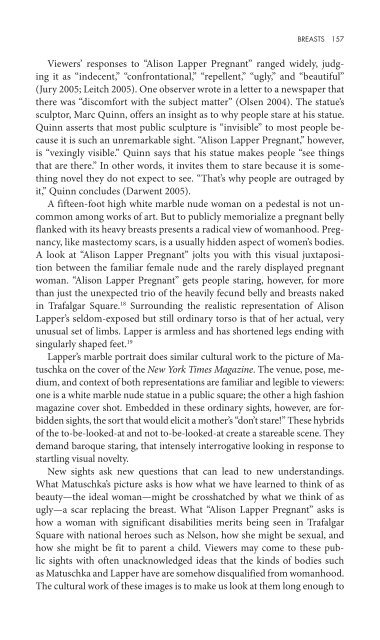Staring how we look sobre la mirada.pdf - artecolonial
Staring how we look sobre la mirada.pdf - artecolonial
Staring how we look sobre la mirada.pdf - artecolonial
You also want an ePaper? Increase the reach of your titles
YUMPU automatically turns print PDFs into web optimized ePapers that Google loves.
74 DON’T STARE<br />
1, 4–7). 13 <strong>Staring</strong> is the rogue poet’s conduit to the reckless vitality at the<br />
American core. Repudiating the fastidious and proper, Whitman seizes the<br />
blunt rudeness of staring as the perfect instrument of fervid connection.<br />
Putting staring to simi<strong>la</strong>r use, the American writer Walker Evans recalls unlearning<br />
not to stare:<br />
I remember my first experience as a café center in Europe. There is staring that<br />
startles the American. I tried to analyze it and came out with the realization that<br />
the European is really interested in just ordinary people and makes a study of<br />
man with his eyes in public. What pleasure and an art it is to study back, and a<br />
relief to me as a young more or less educated American, with still echoing in the<br />
mind his mother’s “Don’t stare!” . . . but I stare and stare at people, shamelessly.<br />
I got my license at the Deux Magots . . . where one escaped one’s mother in<br />
several other senses, all good, too. (Rathbone 1995, 29; italics in original)<br />
Both Whitman and Evans must counter psychological shame and fussy<br />
motherly nagging in order to assert staring as an expansive right of the<br />
manly citizen loosed in a world of compelling curiosities. Evans, especially,<br />
captures the tension bet<strong>we</strong>en his innate desire to stare and the command<br />
“Don’t stare” that echoes “in his mind.” For the American-bred Evans, the<br />
“license” to stare he finds in Paris café culture is a “relief ” from the rule<br />
bound ways of <strong>look</strong>ing, enforced by the now far-off mother, all of which he<br />
has “escaped.” Like our American hero, Huckleberry Finn, Evans flees the<br />
socializing matron by lighting out for the territories in search of adventure.<br />
Out of the suffocating domestic trap of the familiar, these boys head out in<br />
search of manhood into a thrilling world of unfamiliar sights. The particu<strong>la</strong>r<br />
quest for Evans is the dopamine-drenched “pleasure” of staring “shamelessly”<br />
at his fellow humans, of “mak[ing] a study of man with his eyes in<br />
public.” Whitman and Evans both need to work themselves up with visual<br />
ardor to overcome the barriers of social etiquette. <strong>Staring</strong> flings them into<br />
a space of face-to-face interpersonal possibility where they might come to<br />
know something meaningful about those strangers who surround them.<br />
<strong>Staring</strong> encounters stir up anxiety and call for rules because they make<br />
public several cultural contradictions. The first is the paradox at the heart of<br />
the civil inattention that staring vio<strong>la</strong>tes. As <strong>we</strong> have seen, to both cultivate<br />
visual anonymity for ourselves and grant it to others is a rite of American<br />
culture. Yet, this ethic of inconspicuousness contradicts c<strong>la</strong>ims to the value<br />
of the unique individual as a model for citizenship. Our understanding of<br />
ourselves as autonomous, distinct individuals is a fundamental political<br />
principle of democracy (Arieli 1964). At the same time, democracy premises<br />
that each individual is equal to any other. The need to have our individuality<br />
validated through civic recognition of our uniqueness is in conflict with our


